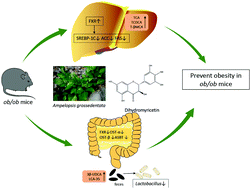Dihydromyricetin prevents obesity via regulating bile acid metabolism associated with the farnesoid X receptor in ob/ob mice†
Abstract
With the high incidence of obesity around the globe, the potential role of bile acid metabolism and gut microbiota in modulating obesity aroused great enthusiasm. Here we studied the anti-obesity effect of dihydromyricetin (DHM), the main biologically active component in Ampelopsis grossedentata, which was applied for thousands of years in the form of tea beverages. A 12-week treatment of DHM significantly reduced body weight gain of the ob/ob mice. Meanwhile, serum parameters that are closely associated with obesity, including levels of total cholesterol, triglyceride, low density lipoprotein, nonestesterified fatty acid, and activity of alanine amino transferase and aspartate aminotransferase were all lower than the non-treated ob/ob mice. Using LC-MS/MS technology, we determined that DHM could enhance the bile acid (BA) conjugation, BA transport in the liver and inhibit the reabsorption of BAs in the ileum mediated by farnesoid X receptor (FXR)-related signalling pathways. Key genes in regulating enterohepatic circulation of BAs were verified by qPCR, and regulators related to FXR pathway were verified by western-blot. We also found that DHM could effectively inhibit the de novo lipogenesis through FXR-SREBP-1C pathway in the liver. In addition, metagenome analysis of the microbiota showed that DHM may affect the activity of bile salt hydrolase by inhibiting the level of Lactobacillus. In summary, the anti-obesity effect of DHM may be attributed to its positive effects on BA metabolism associated with FXR activation.



 Please wait while we load your content...
Please wait while we load your content...